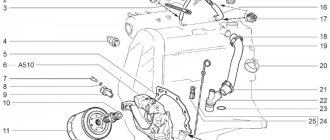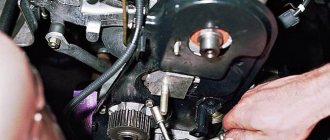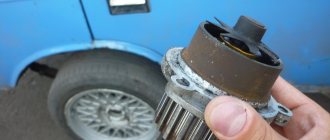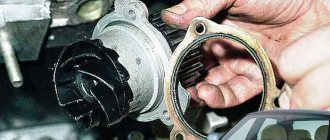This pump is lower, Luzar is shit, and operates from 1.5 - 2 thousand rpm. Pay attention to the impeller.
The factory one has straighter petals, I regret that I didn’t take it after replacing it, but the luzar needs to be replaced.
Catalog number Applicability for engines 21090-1307010-75 2108, 21081, 21083, 2110, 11183, 2111, 21114 21120-1307010-75 2112, 21124 21116-1307010-75 21116, 11186 21126-1307010-75 11194, 21126, 21127
● 8-bladed thermoplastic impeller, which has improved mechanical properties, increases flow and pressure characteristics compared to other analogues. ● Bearing with improved characteristics ensures silent operation of the hydraulic unit. ● New generation “cassette type” oil seal allows to reduce the coefficient of friction between seals. additional information
●Unified branded packaging; ●Indicator label-lock (leaves an original mark on the package); ●Sealing gasket in original color (with special impregnation; installation using sealant is not covered by the manufacturer’s warranty); ●Laser marking (on pump pulley)
WATER PUMP “POWERFULL” = 1100 rubles.
● Upgraded 8-blade thermoplastic impeller model 21117 with increased blade height to create a larger working area to remove heat from the engine. ● A bearing with improved load-carrying characteristics from KINEX, produced in Slovakia; ● New generation “cassette type” oil seal from MTU, made in Italy. Additional information ●Unified branded packaging; ●Indicator label-lock (leaves an original mark on the package); ●Sealing gasket in original color (with special impregnation; installation using sealant is not covered by the manufacturer’s warranty); ●Laser marking on the pulley. Most importantly, when purchasing TZA pumps, pay attention to the production date. The manufacturer officially states that their pumps are not subject to warranty a year after manufacture. To the question: Why are there no storage conditions, temperature, humidity, etc. like for potatoes? Answer: In response to your letter, I inform you of the following: 1. In accordance with the approved technical specifications for this product. 2. Storage conditions do not require information to be placed on the packaging container, because The product, according to the technical specifications, is designed for use in a wide temperature range of the environment (-40 +50 0C). If you store the product in this temperature range, then you should not have problems with the operation of the product in the future. 3. The warranty period is established in accordance with the requirements of Russian legislation. Please inform us which clause of the Russian law does not correspond to the established warranty period.
— Sincerely, Bogomazov D.B. - Head of Quality Control Department of JSC TZA T. From the letter it is clear that the manufacturer is simply avoiding liability under the warranty. They themselves claim that they are not potatoes, but there is no guarantee. From experience, these pumps should not be replaced with others. WATER PUMP “STANDART” WATER PUMP “POWERFULL” is a little better than the standard, but not much. I advise you to install them, or others with straight blades, do not install them with fan blades, you will regret it.
I categorically do not recommend using sealant when replacing the pump, and in the engine in general, especially various super heat-resistant ones that use acids.
Attention!
Do not use sealants with acid that smell like VINEGAR! It will ruin your entire sensor, as it will start the oxidation process. In general, exclude such sealant from cars, and 100% where there is any metal, many have probably seen how in the cooling system, after using such a sealant, oxide appears on the aluminum ends, grooves, micro the cracks, which then leak, and when the engine cools, especially in winter, suck air into the system, and it simply kills the electronics. Any normal manufacturer, including TZA, will void the warranty if you install the pump with sealant...only their gasket!
If you can’t do without sealant, then only this type, inexpensive, and most importantly of better quality, and without acids.
There are currently a variety of brands and manufacturers of water pumps on the market; each manufacturer claims that its products are the best. We will try to impartially figure out what’s what, and consider one of the most popular items - a pump for front-wheel drive eight-valve VAZ cars.
To avoid any confusion, let's clear things up right away. Eight-valve engines on front-wheel drive VAZs were constantly modernized and changed, so the pumps listed below are suitable for all engines equipped with the so-called “eighth” timing belt. If we take it by model, then these are VAZ 2108, 2109, 21099, 2110, 21013, 21014, 21015, as well as Kalinas and Prioras of the first years of production.
We purchased seven samples of pumps from different manufacturers - both domestic and foreign. But before we start introducing the products, I would like to explain some of the terms that are used below.
The impeller is a low impeller, which is located on the reverse side of the main impeller, its purpose is to relieve the shaft-housing seal. Equally important is the presence of holes in the base of the impeller - they also help reduce the load on the mechanical shaft seal with the housing.
A ball roller bearing is a bearing that has balls on one side and rollers on the other. Such a bearing can carry greater loads than a double-row ball bearing.
Functions and purpose of a pump in a car
Normal engine operation is impossible without a cooling system that circulates coolant through the pipeline (system components, pipes and hoses). The purpose of the pump (water pump) is to ensure constant movement of antifreeze throughout the entire system while the engine is running. If at some point the pump stops functioning, this will immediately disrupt the thermal conditions of the engine. In this case, the coolant will boil, which can lead to serious engine damage.
Structurally, the pump is a fairly simple structure, consisting of a metal body and a pulley and impeller located on the shaft. The pulley is driven by a belt from the engine crankshaft. An impeller is located on a shaft inside the housing, which moves the coolant with blades from one part of the cooling system to another. This is how the motor is cooled.
results
After installation, we measured the flow characteristics of the pumps at various speeds. The test results are shown in the table.
The predictably low flow rates of the Kedr pump are easily explained by the rough cast-iron six-bladed impeller without an impeller, which was used back in the days of the production of VAZ G8s. The impeller is a low impeller that is located on the back side of the main impeller. Its purpose is to hydraulically unload the shaft-housing seal. Equally important is the presence of holes in the base of the impeller - they also help reduce the load on the mechanical shaft seal with the housing.
The leaders in terms of consumption are the TZA pumps (due to the use of an impeller of a new proprietary design) and LUZAR, whose impeller, while externally identical, is more developed (the height of the impeller blades is 3 mm higher than some of the samples presented in the test). Both of these pumps also have the smallest gap between the block body and the ends of the impeller, which greatly reduces hydraulic losses and increases flow characteristics.
How to determine if the pump is faulty on Kalina
Despite its simple design, the pump may fail sooner or later. The first signal of incorrect operation of the water pump is extraneous noise that occurs when the engine is running. On the Lada-Kalina, the service life of the device is 60 thousand kilometers or after 48 months of operation. When one of these indicators is reached, it is recommended to replace the part without waiting for signs of malfunction to appear.
A fairly common reason for pump failure is the appearance of extraneous noise, which is associated with bearing wear.
But there are situations when a pump breakdown occurs much earlier than the specified period. Assessing the performance of a node is quite simple. To do this you need:
- Start and warm up the engine to operating temperature.
- Put a glove on your hand and squeeze the upper radiator pipe. When the pump is working, pressure will immediately be felt, which is due to the circulation of liquid through the system.
- If there appears to be little or no pressure, the pump should be inspected in more detail.
To assess the external condition of the pump, you will need to dismantle the timing drive casing and make sure it is in good condition. In this case, you should keep in mind the following nuances:
- If a coolant leak is observed at the junction of the device housing and the engine, it means that the oil seal has failed.
- The appearance of noise from under the hood when the engine is running indicates high bearing wear.
- There should be no axial movement when rocking the drive gear. If there is play, then normal operation of the pump is impossible.
A fairly common failure is the appearance of a coolant leak due to a damaged oil seal.
In these simple ways, the performance of the pump is determined. Even if you have no experience in car repair, you can find a faulty part. If it has been discovered that the pump has some problems, then there is no need to delay repairs, since simple malfunctions can lead to a major overhaul of the motor.
How to lubricate the pump on Kalina
If we talk about servicing a water pump, then we are talking about lubricating the bearings of the device. The design uses two bearings located on the shaft. They don't require much lubrication to function properly, but they are necessary. When working “dry”, the wear of the part increases sharply. With some experience, the pump can be lubricated without removing it from the car. All you need to do is follow these steps:
- Remove the timing cover.
- Remove dirt from the pump and its seating area.
- Apply a little Litol-24 lubricant to the housing joints.
Depending on the installed water pump, the product may have a lubrication hole.
High-quality lubrication can be performed during repair work, when parts that have failed are replaced. But if you lubricate the part in the manner described, you can also provide the bearings with the necessary amount of lubricant.
The original or the Chinese equivalent is half the price: we disassemble and compare water pumps
A little history
Let’s start with a short reminder of what a pump (or water pump) is, why it’s “watery” if there’s been antifreeze splashing in the cooling system for a long time, and why it sometimes has to be changed. At the very beginning of the existence of cars, the cooling system was elementary - open. And there were no pumps there, the system was a thermosiphon: hot water, according to all the laws of physics, rose to the top, cold water flowed down, all this slowly circulated, and everyone was happy. We were happy, but not very happy, because the water consumption was enormous. Due to the fact that water was simply poured into an open tank, it evaporated very actively. Therefore, a logical step was taken: to make the water cooling system closed. The water in it cannot evaporate quickly, which means it does not need to be constantly topped up. And it was also necessary to invent a radiator, because the conventional coil, which was used at the very end of the 19th century, was not efficient enough. At first, he coped with his work in a closed system, but complaints against him remained. Moreover, the system remained a thermosiphon system - without a water pump. Only at the very beginning of the 20th century did the very detail appear that gave the system an almost modern look - the pump. She is also a water pump. The task of the water pump was not difficult, but very important: to drive water inside a closed loop. That’s why the pump was called a water pump, since there was nothing but water in the cooling systems at that time. And since in essence it is an ordinary pump (usually a centrifugal one), the name remains the same: water pump. I'll call it a pump for short. Over time, pumps have become more diverse. Some have “learned” to listen to ECU commands, but most budget cars with simple engines still drive with rather primitive pumps. As a rule, they are quite enough.
What and how?
So, the task of the pump is clear to us: to force the coolant to circulate in the cooling system. It does this quite simply: the impeller drives the flow of antifreeze from the radiator to the block. The drive of the pump can be different, but the most popular is a belt. Most often - by the timing belt, but sometimes it is turned by the serpentine belt of additional units. In theory, this is a fairly reliable unit. But still, it has to be changed periodically. Like any other mechanism with seals and bearings, it wears out over time. At best, the pump begins to leak a little, at worst... There are different options. Wear of the bearings first leads to an unpleasant squeaking noise, which is most often very audible on a cold engine, but disappears as it warms up. If you do not respond to it in any way, the pump may jam. And this is already sad, because if the pump is driven by a timing belt, the latter usually cuts off the teeth, which often leads to valves and pistons meeting on “plug-in” engines. If the pump is driven by a belt of additional units, the consequences can also be bad. For example, it happens that due to the pump jamming, the engine simply stalls at idle - it grabs it too hard by the belt, which, of course, is rotated by the crankshaft pulley. It’s especially disappointing that computer diagnostics in this case will not show anything: there are no errors in the engine, its systems or sensors. And he still stalls. Another unpleasant failure scenario is the failure of the impeller blades. This happens for various reasons. If the blades are metal, they will corrode over time. True, car owners are often to blame for this process because they forget that antifreeze needs to be replaced at least once a decade and there is no point in pouring slurry into the cooling system, which is sold on the market “brotherly” for a hundred rubles. A healthy antifreeze means a healthy pump, so to speak. Plastic impellers simply wear out. And if they are made by the playful hands of a huckster from an underground workshop, they wear out very quickly, causing bewilderment to the car owner who has just installed such a pump. If the impeller wears out, the symptoms of failure will be as if there is no pump at all: the motor gets hot, and in advanced cases it can even “steam”. To make sure that it is the pump that is to blame, a method that has become popular among VAZ owners is suitable: on a warm engine, pinch the pipe coming from the radiator with your hand. If there is no pressure in it, the pump is dead. For other breakdowns there will be more work. You'll have to at least inspect the pump. If it is in antifreeze, it will also have to be replaced. In addition, you need to make sure that it is level. If the bearings in it have already died, the pulley may be slightly misaligned. The same thing happens if some not very decent craftsman stuck a new pump to a dirty mating surface. Unfortunately, in our imperfect world, where Feduk sings and Kristina Asmus stars, such things happen regularly. By the way, if the pump is leaking, you can smell antifreeze. It is so specifically sweet that it is impossible not to recognize it. Before disassembling the pumps and looking at their insides, I’ll say one more thing: pumps often die due to all sorts of stop leaks that are poured into cars with leaky radiators. Risk is, of course, a noble thing, but not always reasonable.
Three from the casket
There are three pumps in front of us. Just out of curiosity, we took these: the original pump from AvtoVAZ (21120130701082), the little-known G-Part product (2112-1307010) and the most affordable Chinese pump from Gallant. All of them are suitable for VAZ 2110, 2111 and 2112 with a 16-valve engine. Let's see what these pumps are. Let's start with the original. After all, this should be the standard, and all other pumps should be the envy of it.
I won’t discuss the box – the box is just a box, nothing interesting. Let's move straight to the pump.
If you don't look closely, there is nothing strange about it. The impeller, by the way, is plastic.
If you start looking more closely, there are some comments. Firstly, it was still not done very carefully. For example, there are burrs sticking out everywhere on the chamfers. However, this, as they say, “does not affect the speed,” and you shouldn’t find fault with it.
But the second remark is very significant. Gentlemen, you can’t do the pulley that drives the timing belt like that!
I wonder if you buy ten VAZ pumps, will this defect be repeated on at least one more? I hope not, but seeing this on an original part is a little painful. Well, let's take it apart.
Let's start by removing the shaft bearing retaining screw. This requires a hexagon, but there is nothing complicated in the process itself.
Then the pump is also very easy to disassemble. Using a puller, we pull off the pulley, then with the same puller we easily squeeze the shaft towards the impeller. There is no additional fixation of the pulley and bearing, so anyone (who has a puller) can do it. As a result, we get a separate housing, pulley and shaft with a bearing and impeller.
The inside of the pump looks even better than the outside. Everything is quite neat. It’s good that the shaft bearing is fixed with a screw and not with sealant: it’s convenient to disassemble. True, it is not clear why to do this: if the pump dies, it is easier to install a new one than to try to repair the old one.
As you can see, there is nothing complicated inside the pump. And yet it sometimes requires replacement. It is impossible to estimate the bearing life by eye, but you can say something about the original pump.
The advantages include a high-quality case that easily survived disassembly, ease of disassembly itself, and generally good quality of surface treatment that requires it. The disadvantages are a rather obscene attitude towards those surfaces that are not adjacent. They just had a bolt hammered into them. This is probably the result of finding a compromise between price and quality, so there’s nothing to complain about either. This approach is acceptable. But knocked down edges of a pulley gear are a serious problem. It will certainly affect the life of the timing belt, because these strange notches not only change the relief of the tooth in height (which can be survived), but also protrude beyond the dimensions of the tooth in width. This means the belt will wear out. It is unacceptable. We can only hope that this marriage is an isolated incident. The second pump is the Chinese Gallant. A very funny product, to be honest.
It looks good from the outside. The impeller is metal.
The quality of processing also looks decent, although the ends of the pulley teeth are not processed very carefully.
Everything glitters and sparkles so that you can’t take your eyes off it. But let's try to take it apart.
It seems to be similar to the original, but it’s not. Let's look at the body.
It began to fall apart even at the stage of removing the pulley, although the puller does not touch the body at all during this process (it holds the pulley with its paws and presses into the shaft). As soon as I pressed the body in a vice a little, a piece fell off of it. “Perhaps I overdid it,” I thought. Just for fun, I took some pliers and... broke off another piece of the body. Then more. In general, I don’t know what this case is made of. Something like pressed foil.
Structurally, the pump also differs from the original. There is no screw that secures the shaft bearing. The shaft is sitting on some kind of blue sealant. And it sits very firmly. It is impossible to pull it out, as on a VAZ pump towards the impeller: a ledge is cast inside the body into which this shaft rests. Therefore, you first need to remove the impeller and push the shaft from the bearings towards the pulley. We broke the housing anyway, so we didn’t spare the pump and pressed out the shaft with a hydraulic press in the same way as on the VAZ pump. At the same time, the hull was broken, but there was nothing to lose.
The layer of sealant was not pleasing: in some places it was thick, in others it was empty.
The advantage of the pump is the cost. It cost us 772 rubles, but the original one cost 1,602 rubles. The difference is obvious.
The downside is the quality of the case, not very high-quality assembly. I could also add something about the inability to quickly disassemble it, but I won’t. This, as I said, is no longer relevant for a long time, and the pumps are replaced as a whole. The third pump is interesting because it is packaged under the g-part brand, which is still unknown to me. The box differs from the previous two at least in its higher quality printing and the fact that it is glossy. This has absolutely no effect on the quality of what’s inside, but I have a kind of warm relationship with glossy boxes. Probably in a past life I was a magpie and loved everything shiny. But it's not as interesting as a sticker with a part code. With its help, you can check the authenticity of the part on the g-part website. It's a small thing, but nice.
If the part is genuine, then it has a two-year warranty. Also good. But we are more interested in what lies inside.
And inside there is a regular pump. There are no questions about her appearance. The pump is very similar to the one we bought for 772 rubles: the workmanship is also of very good quality and the impeller is also metal.
The processing of the pulley teeth also does not raise any questions: there are no burrs, much less dents, as was the case on previous pumps.
Let's take it apart. Structurally, this pump is the same as the previous one: it is difficult to disassemble, and we only did it with the help of a press. You can also remove the shaft only towards the impeller, and not the pulley, as on the VAZ pump.
There is also no locking screw here, and all the parts just fit tightly. However, the housing turned out to be much stronger than the housing of the cheapest pump. They even completely disassembled it: they removed the pulley, the impeller, and the shaft with the bearing.
1 / 3
2 / 3
3 / 3
It’s even strange, but there are no questions about this pump at all. Despite its origin, its body turned out to be strong, and its assembly was quite decent. The puller and press left scratches on the body, of course, but nothing fell apart.
What's the result?
Of course, it is impossible to evaluate a part without a full life test. But even the minimum that we saw during disassembly of the pumps (and in the case of the VAZ pump, without disassembly, but directly on the pulley), allows us to draw some conclusions. Only one pump cannot get a positive rating - this is Gallant for 772 rubles. It breaks too easily with pliers. Maybe, of course, it will serve, but it doesn’t inspire confidence at all. True, it costs, I repeat, a penny. The original is good, but its reputation was greatly spoiled by the notches on the pulley teeth. Apparently, quality control is not the company's strong point. However, if you at least carefully inspect this pump before installation, there should be no problems. A significant disadvantage is the cost of 1,602 rubles, which is more than two times more than the first Chinese product. More precisely, a Chinese craft. I’ll go into a little more detail here. It is likely that this pump would have shown its best side in a resource test. But we all know about the “plug-in” nature of modern engines. So the timing belt is sacred to them. The pump started whistling - I replaced it and forgot about it. But if the belt breaks... In general, even an external examination allows us to draw some conclusions. The g-part pump is the golden mean. There seem to be no complaints about the quality: the body is durable, looks neat, and is well assembled. The kit, like previous samples, includes a gasket. The cost of the pump is 1082 rubles, which is noticeably more interesting than the VAZ part. Of course, I would like to check how it would behave in a bearing test, on which the life of the pump mainly depends, but, alas, today we have the wrong format. But if you try to evaluate the pump based on external parameters, then I would probably install this particular pump. Well, or the original, if I found a non-defective part.
Replacing a pump on an 8-valve Kalina
On a Kalina with an 8-valve engine, replacing the pump is not so difficult. But if a novice car enthusiast needs to do the work, he often has various questions. For example, what part to choose, what tool will be needed during work, what to do and in what order.
Which pump to choose for Kalina
When the time to replace the pump approaches or the part fails, many Kalina car owners are faced with the problem of choosing a pump. It’s clear that car owners want it to work for as long as possible. In order not to make a mistake, you need to consult with experts and read the reviews of other drivers. However, preference should be given to factory-made products.
When purchasing, pay special attention to the packaging: it must be of high quality, uncreased, with a gasket inserted inside, a warranty card, and a specified service life of the part. A high-quality product is packaged in a box with a holographic sticker. A TZA pump is installed, which has a fairly long service life.
You need to approach the choice of pump with all responsibility and not purchase a part from an unknown manufacturer.
The most preferred manufacturers of water pumps include:
It is quite difficult to answer unequivocally which manufacturer’s pump is better. Each detail has its own pros and cons. Which option to choose depends only on the owner. Pumps from VAZ-2108–09 and 21114 are also suitable for the 8-valve Kalina.
Video: review of water pumps for VAZ
Where is the pump located on Kalina?
On the Lada-Kalina car, the pump is driven by the timing belt and is part of the gas distribution mechanism. To carry out repair work, you need to look for the pump on the right side of the power unit. Without removing the timing belt, only the device pulley can be seen.
The water pump on the Lada Kalina is located on the right side of the engine
What tools will you need?
To replace the pump, you need a standard set of tools (wrenches, sockets), as well as a 6-point hexagon. It is necessary to select a suitable container and rags for draining the antifreeze in order to minimize engine contamination. Even though a new gasket is used when installing the part, for reliability it is recommended to use a sealant with high thermal conductivity.
To replace the pump you will need a standard set of tools that every car owner should have at their disposal: keys, sockets, screwdrivers
Preparatory activities
Preparing to remove the pump comes down to the following steps:
- It is necessary to remove the engine protective splash guard. It is secured with 10mm turnkey bolts.
- Remove the positive terminal from the battery, as well as the high-voltage wires from the ignition coil. The coil, so as not to interfere with free access to the antifreeze drain, is removed and put aside. To do this, use a 5 mm hex key to unscrew the coil bracket fasteners.
- Drain the coolant from the cylinder block into a prepared container by unscrewing the drain plug with a key to “13”, and also unscrew the expansion tank cap.
- If the antifreeze needs to be drained from the radiator, then move the container under the drain hole and unscrew the plug.
Test samples
For testing, we chose the most common water pump model with the original number 21126-1307010, popularly known as the “Prior pump”, which since 2007 and is still installed on all 16-valve 1.6-liter VAZ engines. These engines come standard with a Gates belt with a semicircular tooth profile and an automatic tension roller. The declared belt resource exceeds 100 thousand km, so the water pump should last until the timing belt is scheduled to be replaced.
Which pump should I install?
The choice of which pump to install will depend on logistics, in particular. However, there are a number of manufacturers that are ubiquitous, and their products are used by the majority of domestic car enthusiasts. The following is a list compiled solely on reviews and tests of individual car pumps found on the Internet. The rating does not advertise any of the brands listed in it.
Metelli
The Italian company Metelli SpA produces a wide variety of auto parts, including car pumps. The products of this company are sold in more than 90 countries around the world, which indicates their high quality. Pumps are supplied both to the secondary market (as a replacement for failed units) and as original ones (installed on machines off the assembly line). All of the company's products comply with the international quality standard ISO 9002. Currently, the company's main production facilities are located in Poland. It is interesting that many auto parts, including pumps, produced under the brands of such well-known automakers as Peugeot, GM, Ferrari, Fiat, Iveco, Maseratti and others are produced by Metelli. Therefore, their quality is high. In addition, it is noted that products of this brand are rarely counterfeited. But it still makes sense to pay attention to the quality of packaging and other precautions.
Reviews from car owners and mechanics who have used Metelli pumps are mostly positive. There is a virtual absence of defects, very good processing of the metal of the impeller, and durability of the device. In addition to the pump, the original kit also includes a gasket.
A significant advantage of Metalli car pumps is their relatively low price with very good workmanship. Thus, the cheapest pump as of the beginning of 2019 costs about 1,100 rubles.
The Dolz trademark belongs to the Spanish company Dolz SA, which has been operating since 1934. The company specializes exclusively in the production of automobile pumps for cooling systems, both for cars and trucks, as well as for special equipment. Naturally, with such a targeted approach, the company produces extremely high-quality spare parts under its own brand. The Dols company was one of the first to start producing aluminum pumps, which not only reduced the weight of this unit, but also made the cooling system more technologically advanced.
The company's products cover up to 98% of the European automaker market and are also exported overseas. In particular, the products have a Q1 Quality Award and are used for cars manufactured by Ford. Quite often, Dolz products can be packaged in boxes from other packaging companies. So if you have such information, you can buy a high-quality car pump even cheaper.
The reliability of Dolz water pumps is especially distinguished by the quality of the impeller. This is ensured by the use of special aluminum casting and mechanized assembly. An additional advantage is that they are practically not counterfeited. Thus, the originals are sold in branded packaging marked TecDoc, and at the same time its geometry is perfectly respected. If there is a fake on sale, it will cost little money, while the original Dolz pumps are quite expensive. This is their indirect disadvantage, although their service life offsets it.
The price of the cheapest pump of the mentioned brand as of the above period is about 1000 rubles (for a classic Zhiguli).
SKF is originally from Sweden. It produces a wide variety of products, including water pumps. However, the company's production facilities are located in many countries around the world, in particular, Ukraine, China, the Russian Federation, Japan, Mexico, South Africa, India and some European countries. Accordingly, the country of origin may be indicated on the packaging differently.
SKF car pumps are of the highest quality and serve car enthusiasts for an extremely long time. Judging by the reviews found on the Internet, there are often cases when the pump is changed after 120...130 thousand kilometers, and this is done only for preventive purposes, changing the timing belt. Accordingly, SKF water pumps are fully recommended for use on any vehicle for which they are intended.
Signs of pump failure
You can talk about a pump malfunction if you have the following malfunctions:
- The coolant level in the reservoir drops to a minimum . This reason is the most common, since this is how you can understand that the coolant is constantly leaving due to leaks. They can be in the tank itself, the pipes, or at their connections, as well as directly in the radiator. Only by checking the entire system can you be sure that this is not the reason.
Coolant level is at minimum.
A clear example of a new and old pump.
Note! Remember that with a stably functioning, working pump, the arrow on the dashboard very rarely climbs to the red mark. This can only happen in the summer, in the heat, when the car is idling or at high speeds.
Remember that the coolant temperature should not be higher than 97 degrees Celsius.











